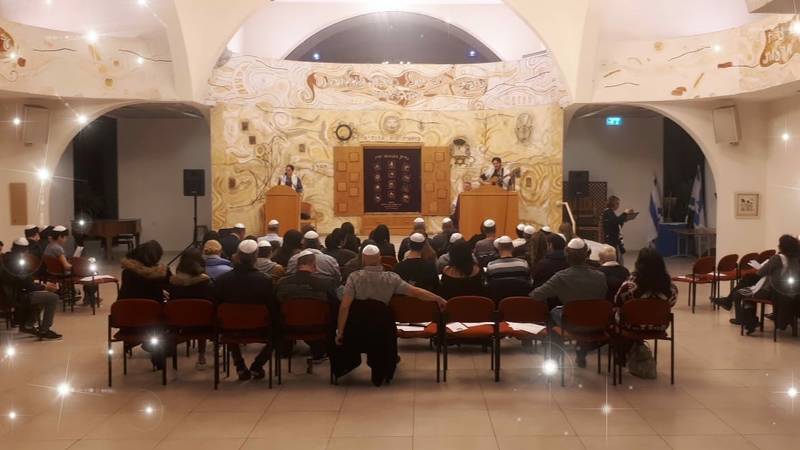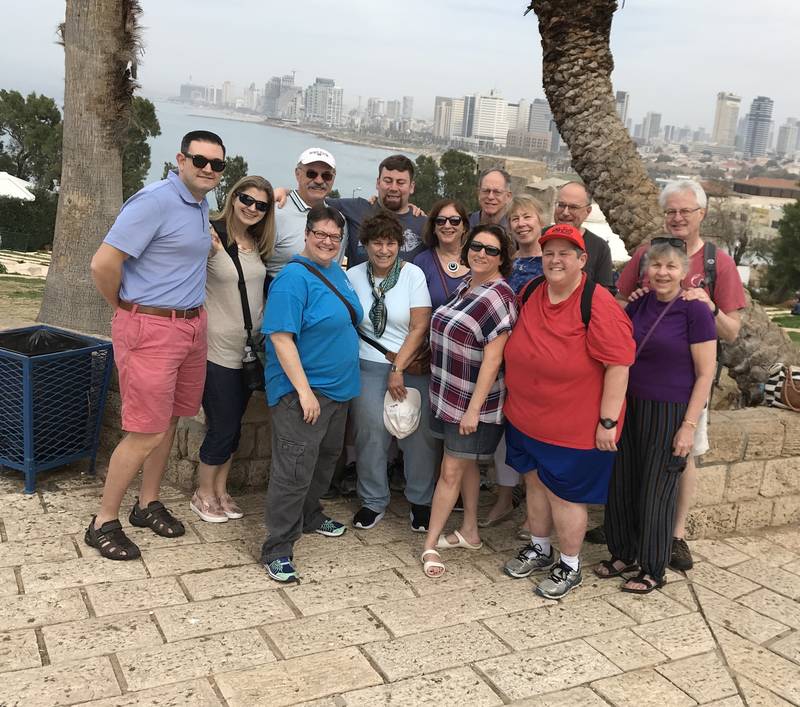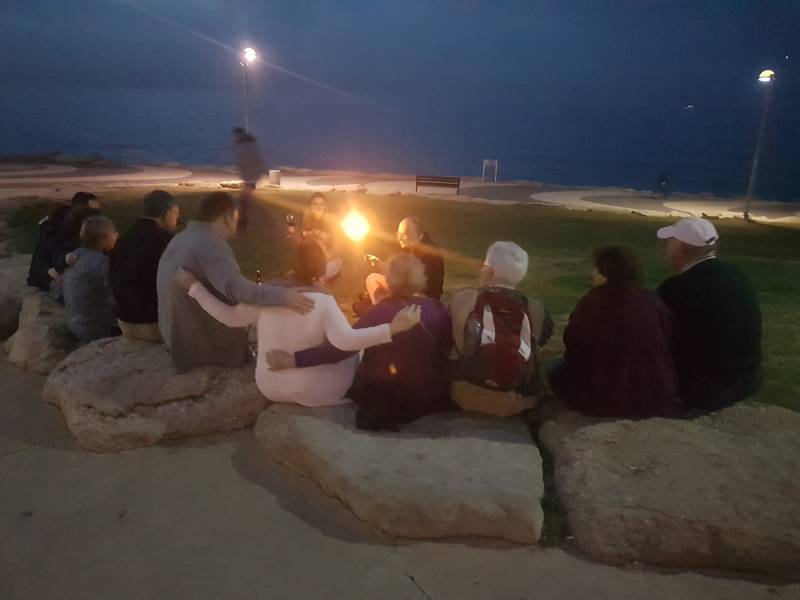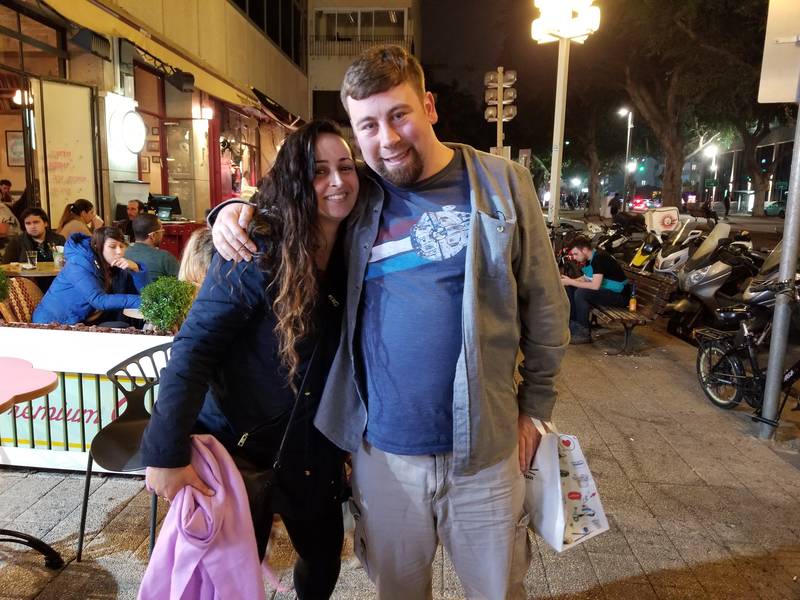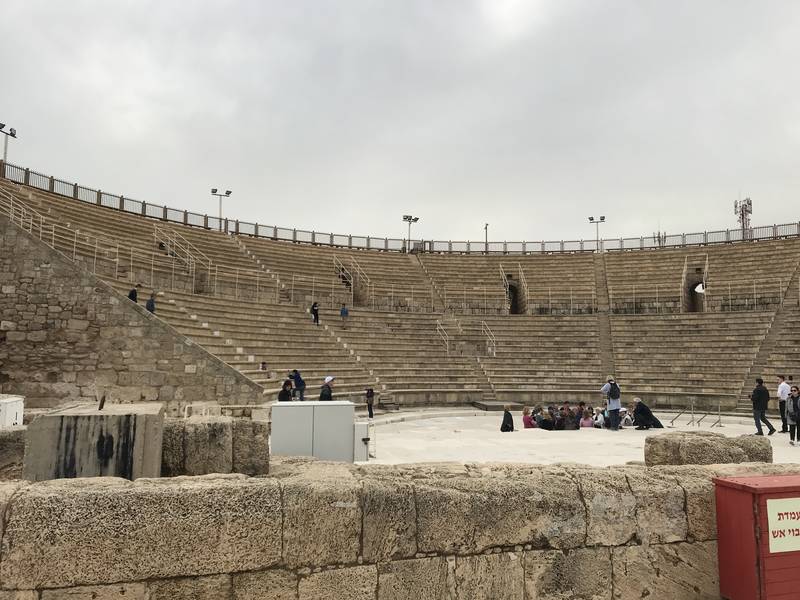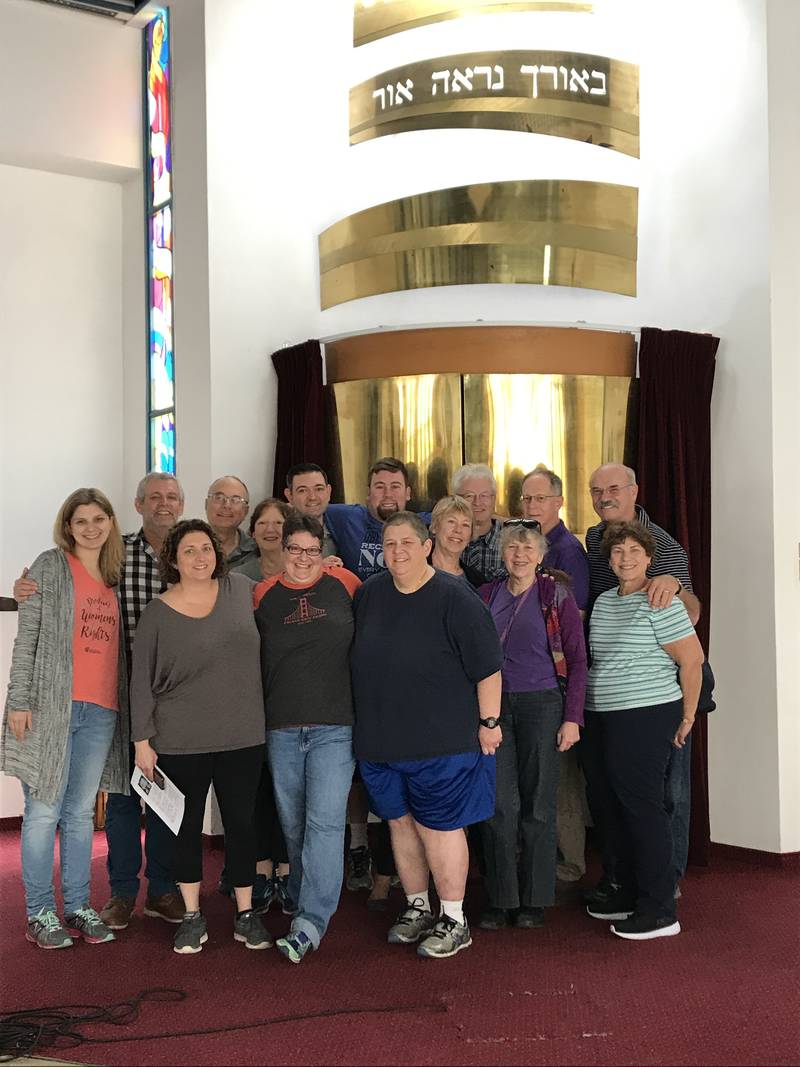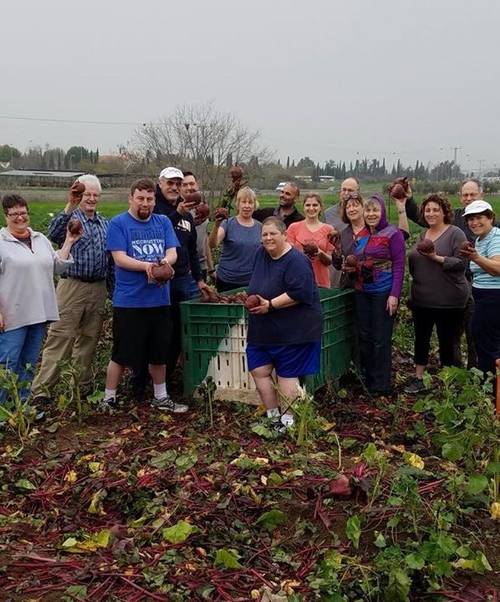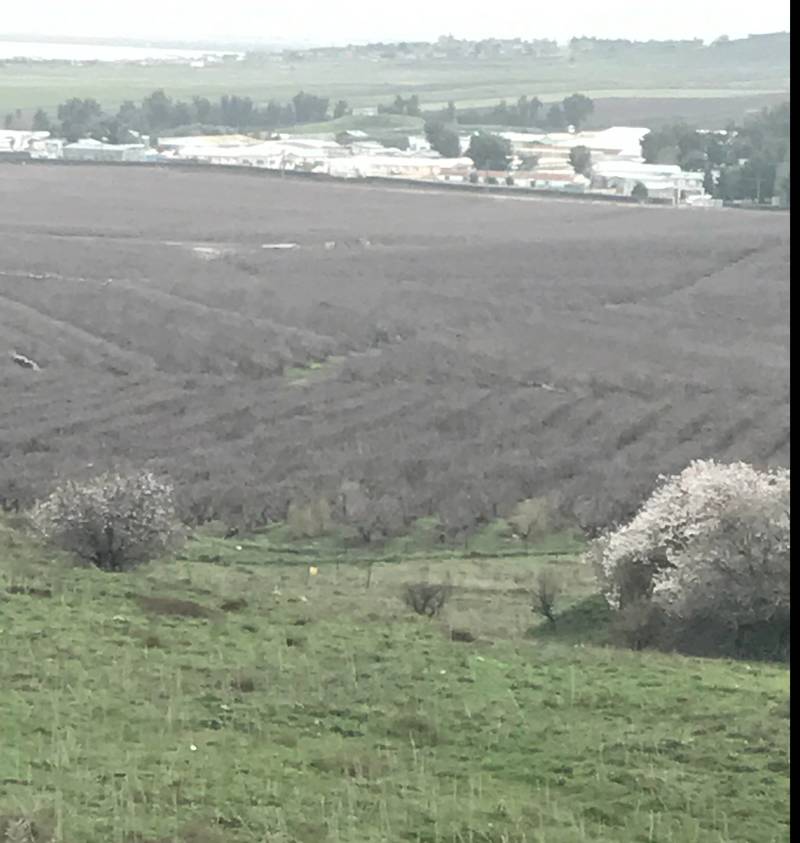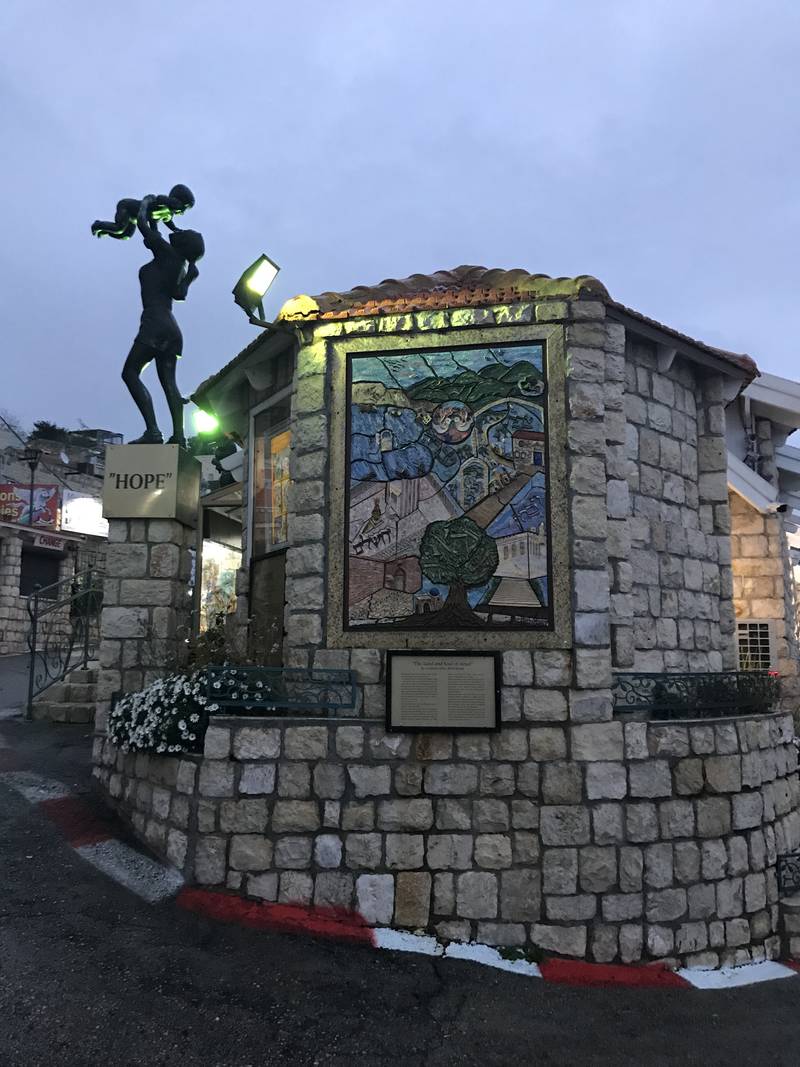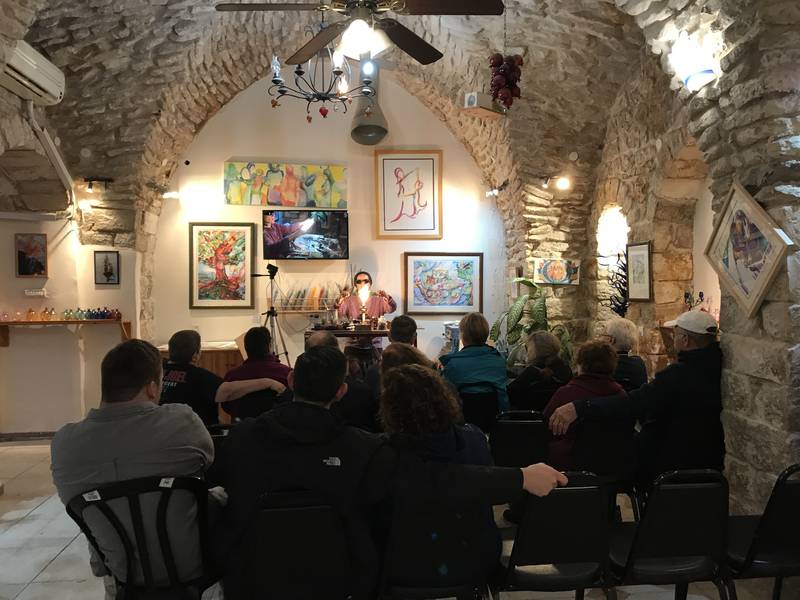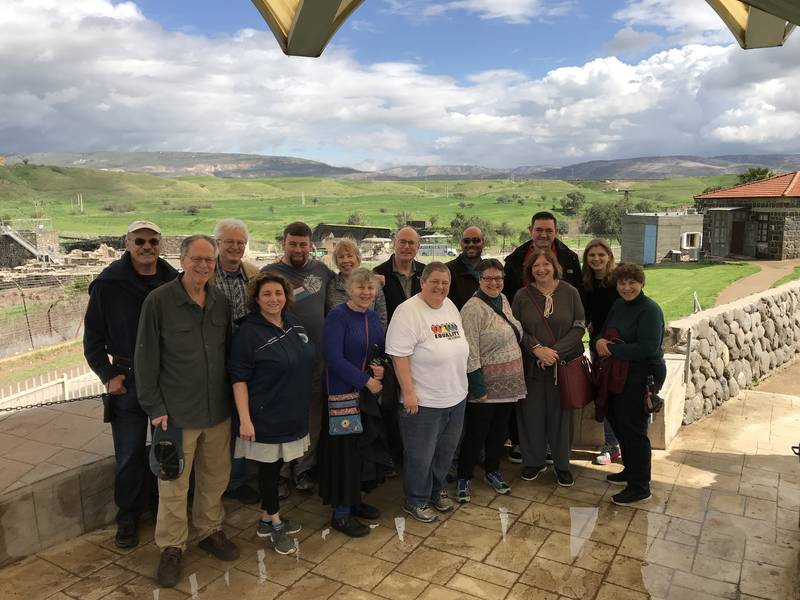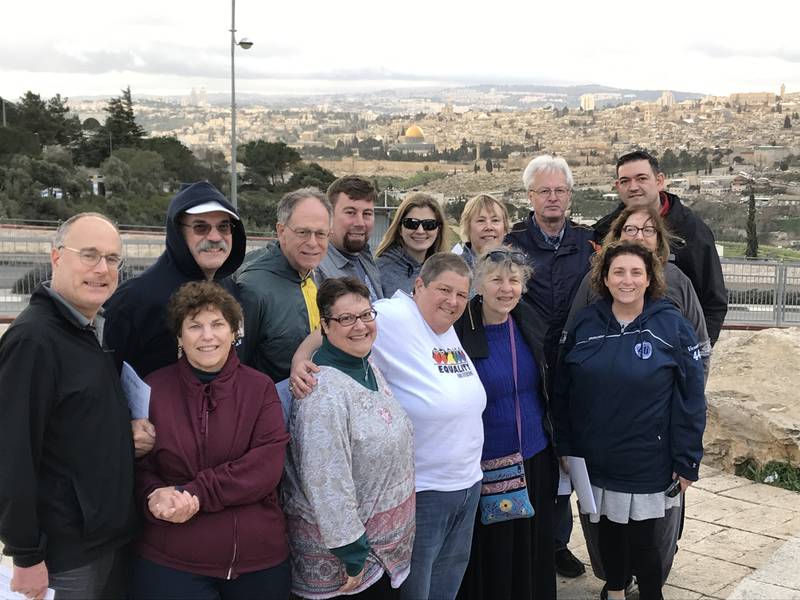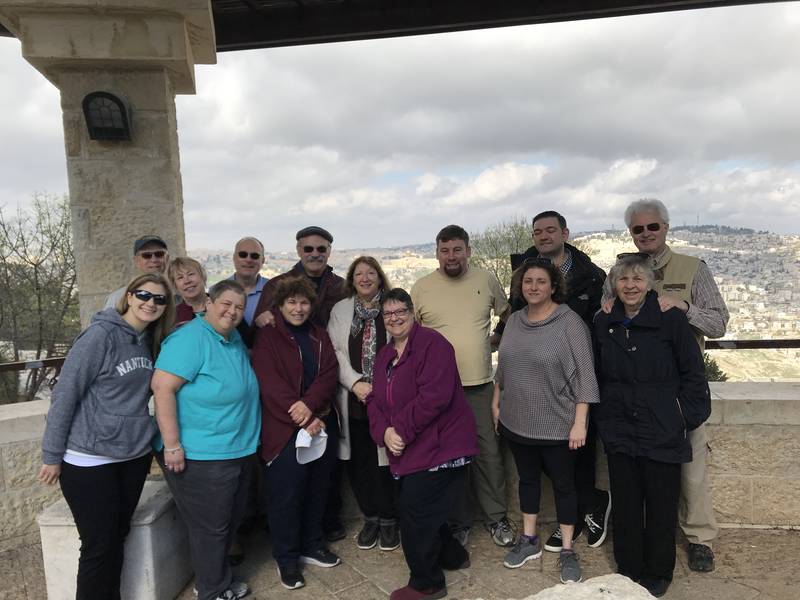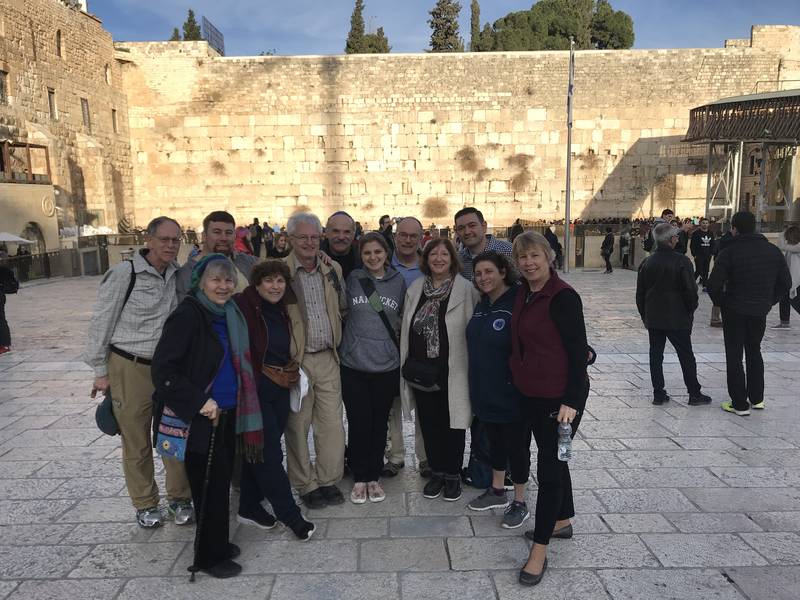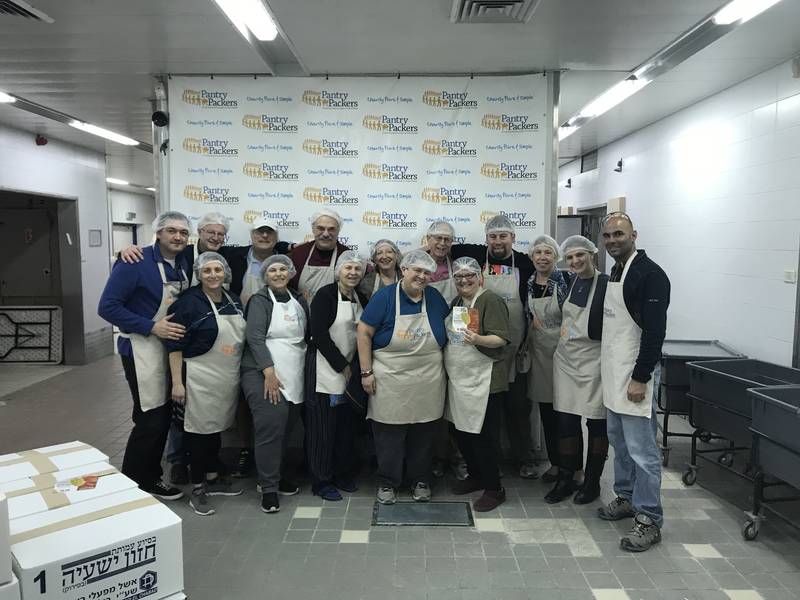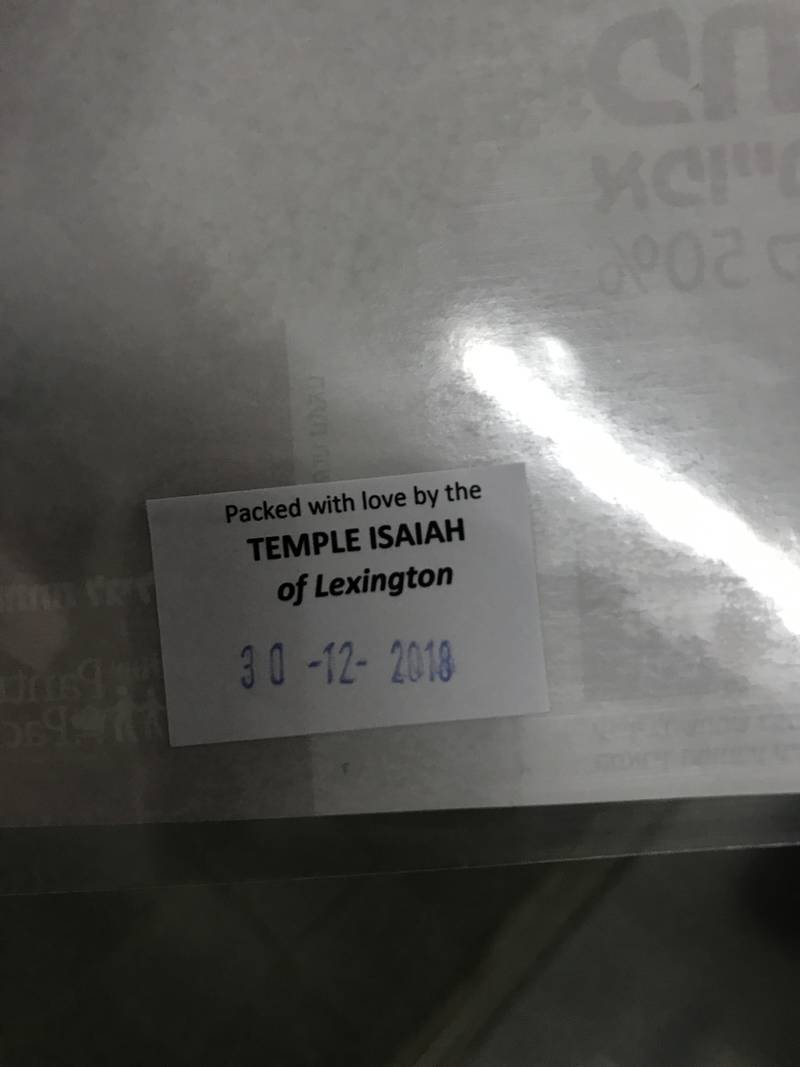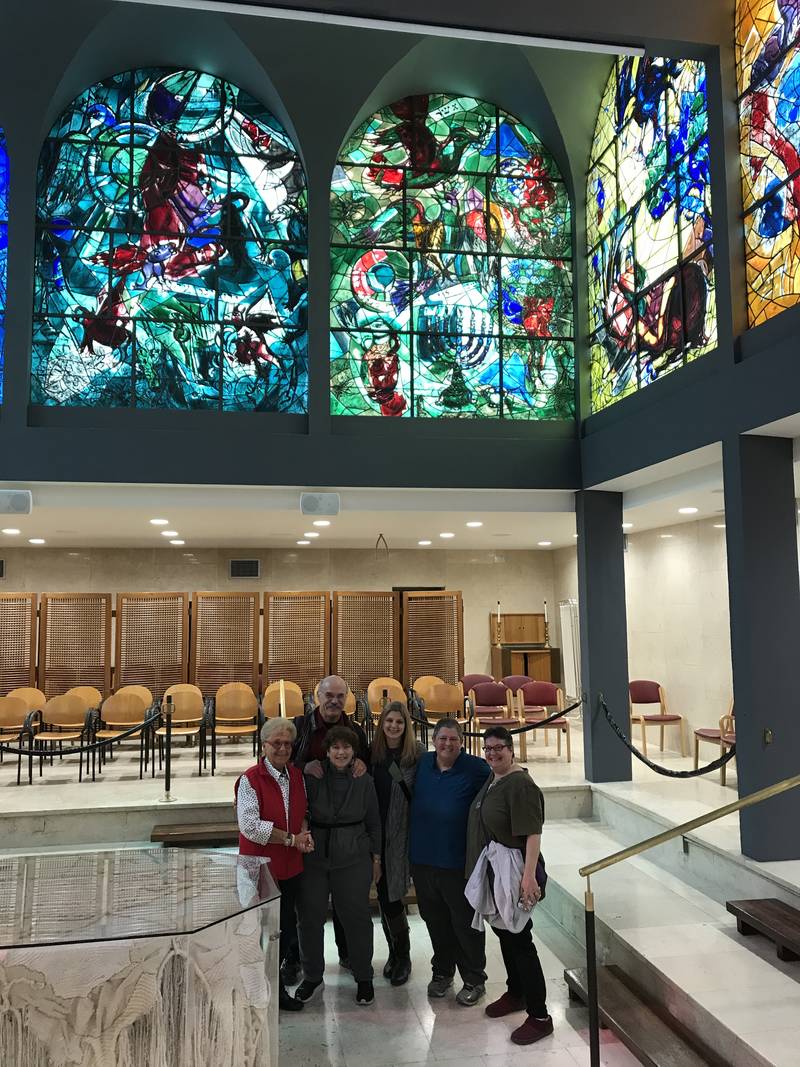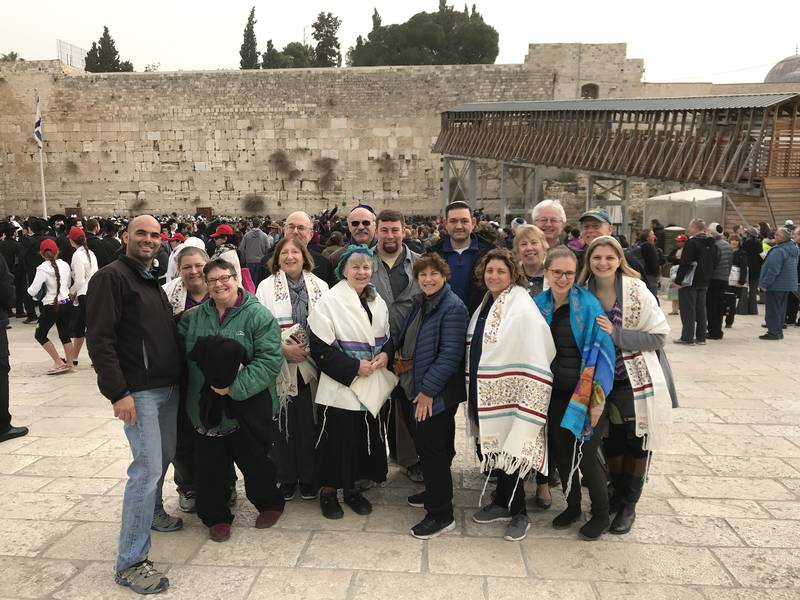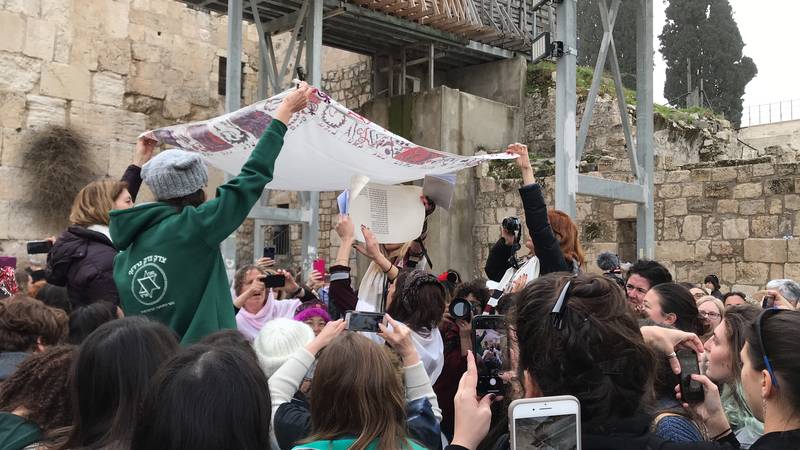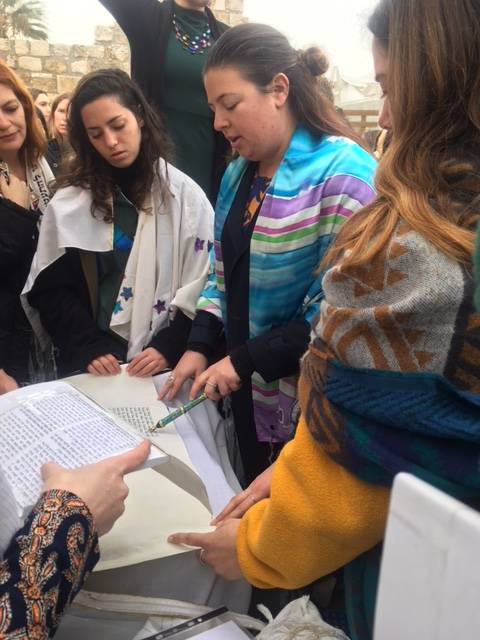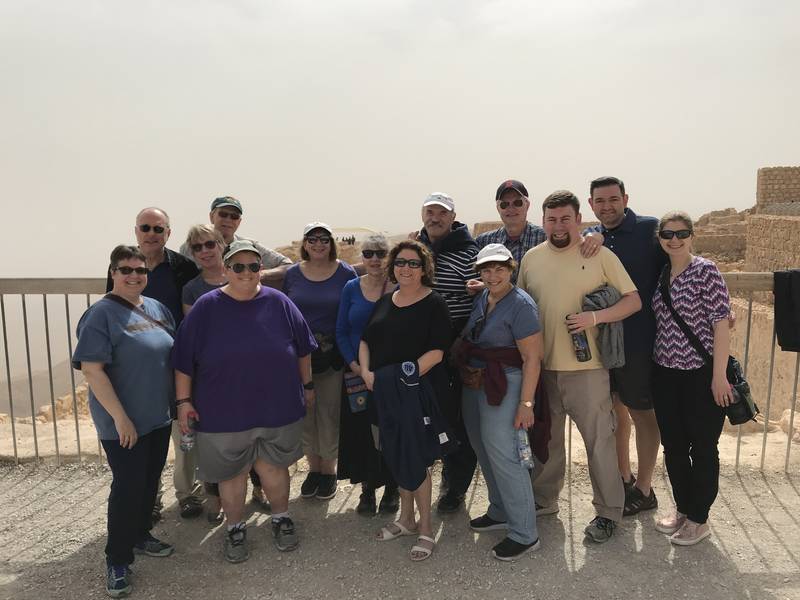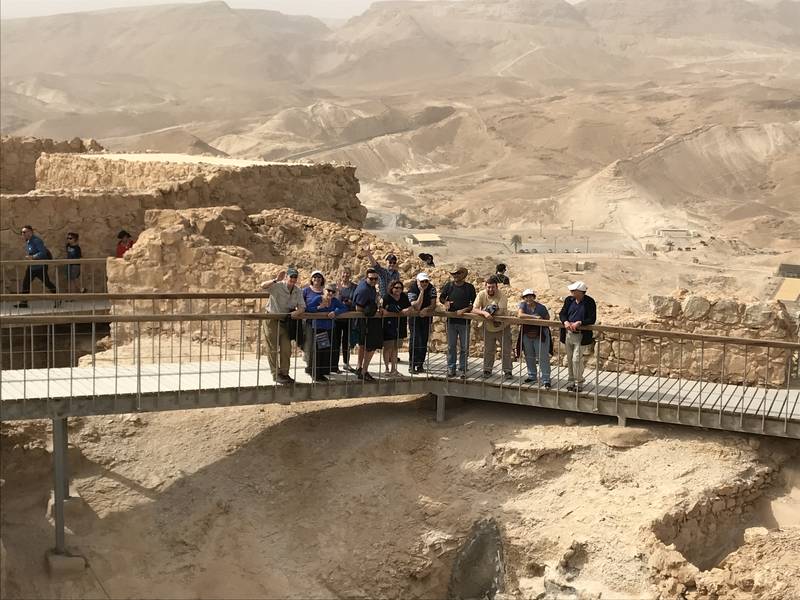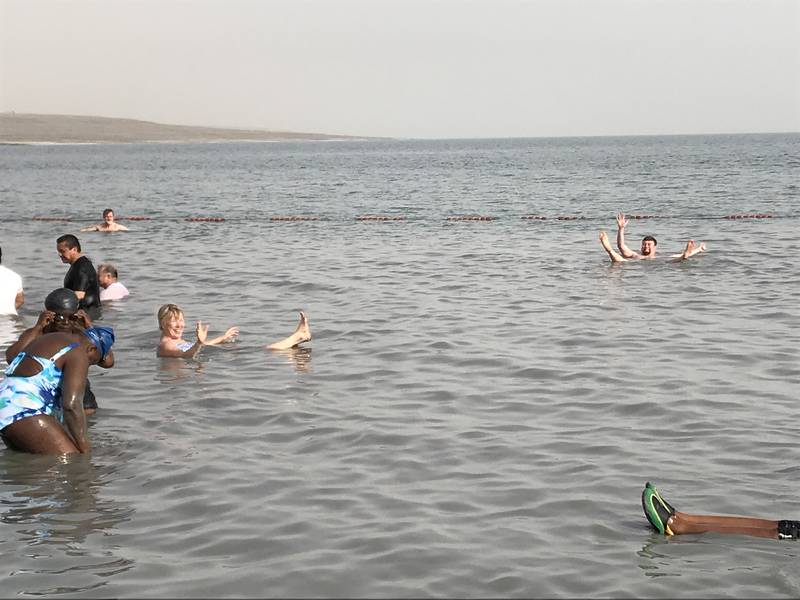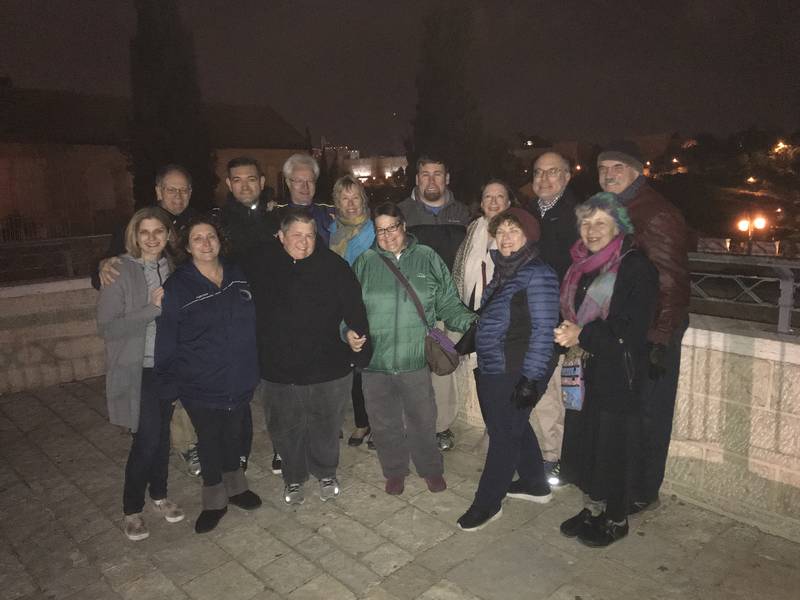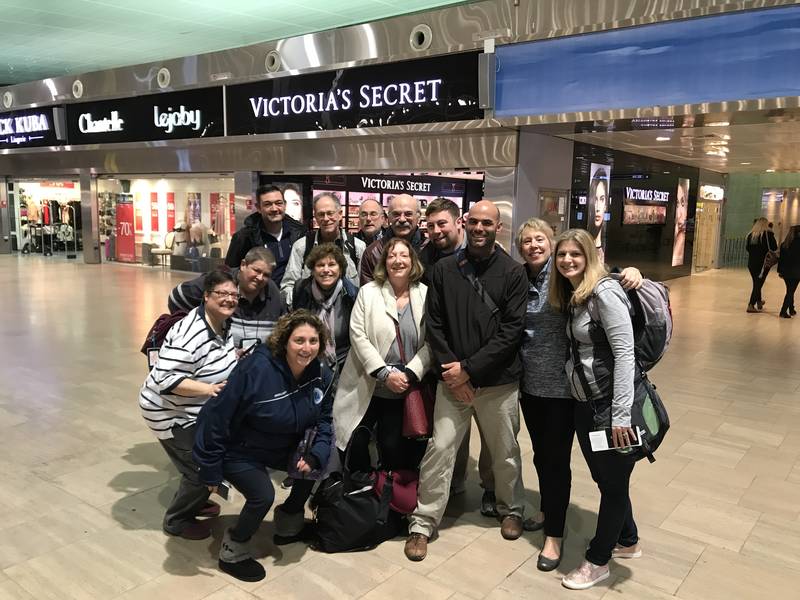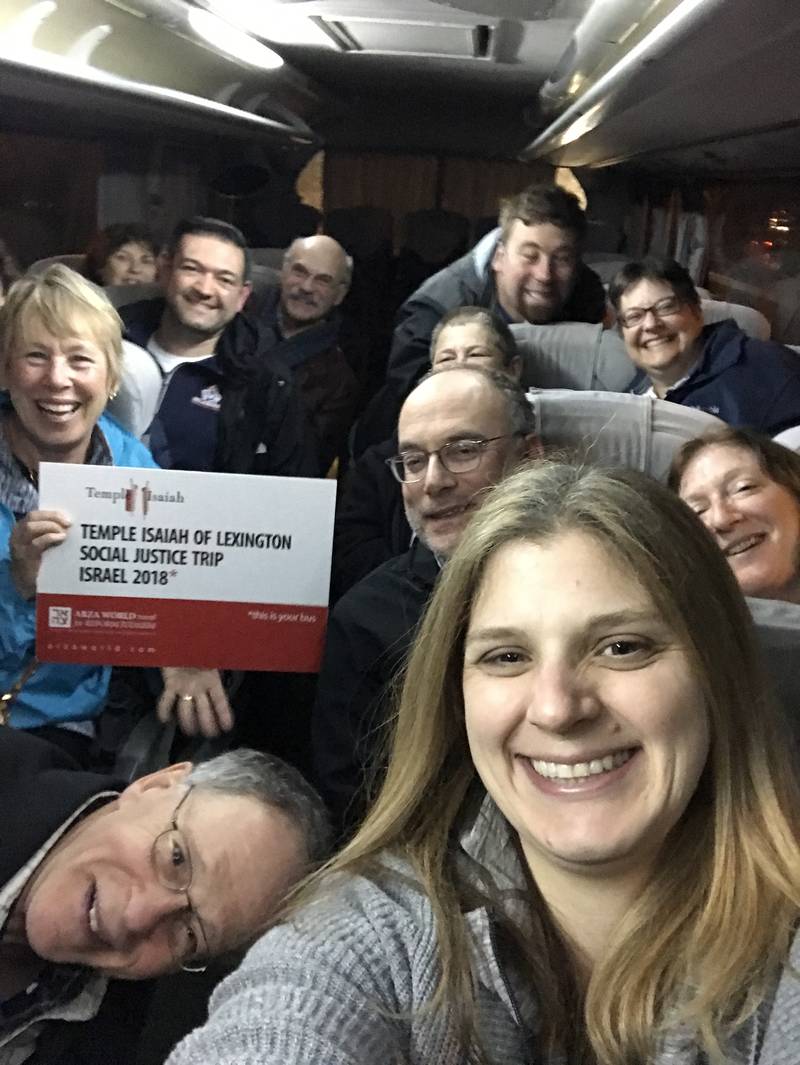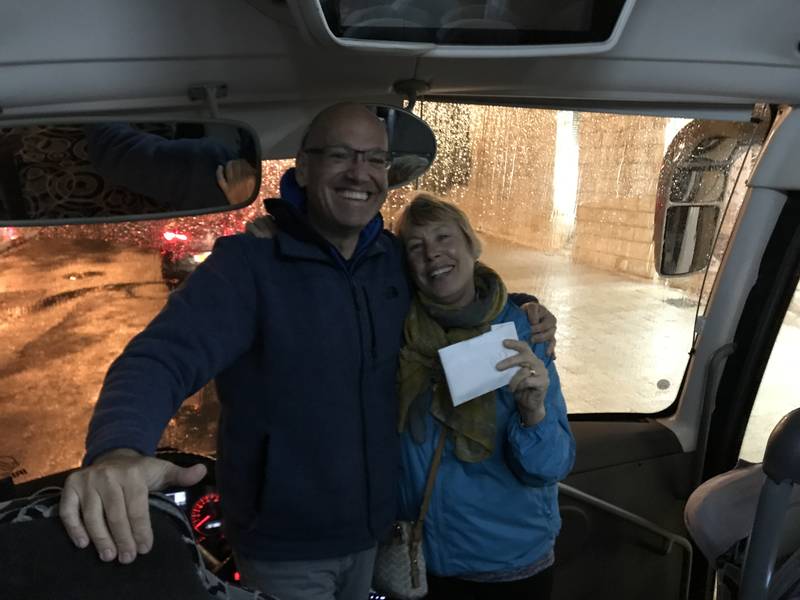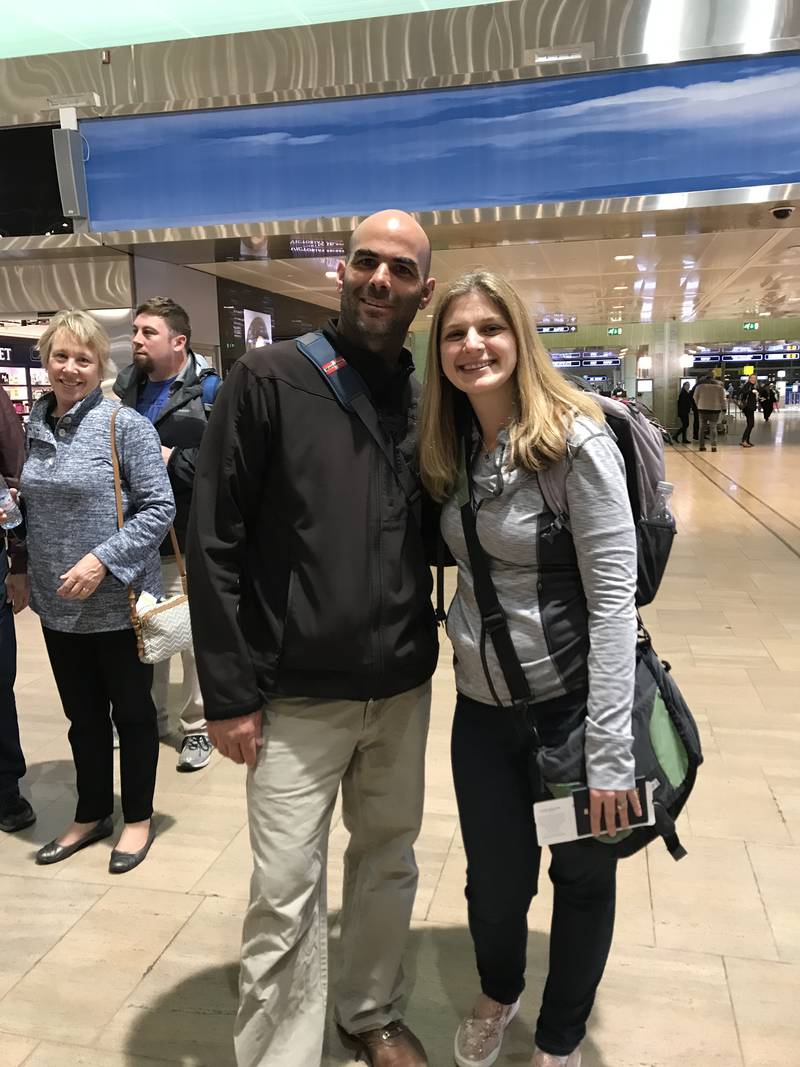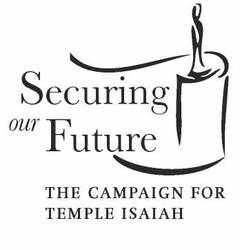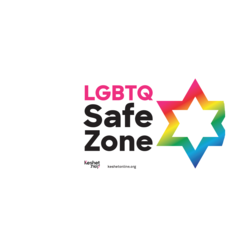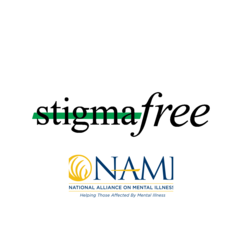Rabbi Perlman - Israel, Feb. 2018
Social Justice Trip to Israel with Rabbi Jill Perlman: February 8 - 18, 2018
Blog Entry 2 by Rabbi Jill Perlman:
Touched down in Tel Aviv just a few hours ago. Just in time to join Beit Tefilah Israeli for a solidarity Shabbat prayer service with refugees from places including Eritrea and Sudan who are at threat for deportation. We are here on a Justice-based Temple Isaiah - Lexington, MA trip - from one side of the world to the other, we are being asked fundamental questions about who we are and what is our responsibility towards preserving life and enhancing it. And from one side of the world to the other, I turn to my Jewish tradition which tells me to remember that I was once a stranger, too. Proud to stand on the side of compassion and justice in Boston, DC, and Tel Aviv. Shabbat shalom.
Blog Entry 3 by Sherry Brodner:
The airport and getting to Shabbat services was a bit of a whirlwind. The synagogue, Beit Daniel was beautiful and the congregation and Rabbi so welcoming.
Mysticism, tradition and modern art made the Sanctuary bright and cheery.
Jews from around the world committed to social justice, peace and Reform values and welcoming the stranger gathered together. The Rabbi spoke about welcoming the stranger. We’ve all been strangers in foreign lands. Shabbat shalom. #no deportations #no racism #no ripping families apart
Blog Entry 4 by Karen & Jake Maslow:
Wow, our first full day in Israel was jam-packed!
Starting with a former Kibbutz (now a historic site) that played a crucial role as a cover from 1945-48 for an underground clandestine munitions factory that was essential to young Israel’s defense. It was amazing seeing this actual secret factory and even more amazing to learn they made 2.5 million bullets for Israel’s defense almost right under the nose of the British military command.
From there we visited Jaffa, an important seaport throughout history as far back as the pharaohs. Today Jaffa is alive with locals and tourists with it’s restaurants, shopping and architectural charm.
From there we went to Rabin Square and to the site of Rabin’s assassination, learning details and reflecting upon this tragic loss.
Being together for Havdalah at the water’s edge in Tel Aviv was magical. And finishing out the day over wine at a cafe on the beach was the cherry on top!
Jake & Karen Maslow
Blog Entry 5 by George Foote:
After a lovely Havdalah together on the beach in front of our Tel Aviv hotel after a great first day, we met Dan, a Perlman family friend, who is in Israeli army. He spoke about Israeli army life and how recent events affected the army’s call to readiness.
He said that despite the country’s fears that trouble could break out after our own President announced his Jerusalem recognition policy, things were thankfully pretty quiet. He felt that because many Palestinians benefited from work permits that yielded wages 2.5 times what they could make in the West Bank where they lived, most Palestinians did not want to see a suspension of all work permits (and their much needed wages) that would happen if a terrorist event took place.
On our last visits to Israel in 1996—97 and then again in 1998—99, I got the clear impression that many Israelis felt we should refrain from supporting Arab owned businesses, and instead buy from Jewish owned concerns. Some still, of course, do believe that. But Dan’s comments supported what I have always felt, that in the long run, giving Palestinians an economic stake in the Israeli society will encourage peace. I am a realist and believe in showing and keeping strength, but Dan reminded me about the importance of finding common ground. It is as much true between peoples as it is between people. May it be so.
Blog Entry 6 by Alex Maslow:
The most important part of Israel, for me, is the people that I know who live here. Today, I got dinner with a friend of mine whom I haven't seen since 2008 - when we worked together at Camp Eisner. It was wonderful to reconnect with her and pick up right where we left off so long ago. I will always treasure the personal connections I have with Israel.
Blog Entry 7 by Robin Lipson & Matt Fishman:
Amazing way to start a week
Is there any better way to end one week and start the next than Havdallah on the beach in Tel Aviv? There was a warm breeze, a mostly cloudy sky with a glimpse of sun setting over the port of old Yafo, people walking, jogging, and playing along the boardwalk, and the sound of our group singing and wishing each other shavua tov and a week of peace. Truly a moment to savor and remember.
We started today at Caesaria, then visited Congregation Or Hadash. It was affirming to see how support from our Congregation and others like ours in the US has helped the reform Jewish community in Haifa. We ended the day at Leket (www.leket.org ) where our group harvested pounds and pounds and pounds of red beets, which will be distributed to organizations that help those who are food insecure. We are dirty, covered in mud and beet juice, but very happy!
Robin and Matt
Blog Entry 8 by Roz Verone:
Even though it was a rainy day, rain is something special to experience and embrace while in Israel. The rain and cooler air made it seem very spiritual knowing that we were headed to some amazing places and staying at Hagoshrim and their motto is hotel & nature. First stop today was Tel Dan Nature Reserve it was so interesting to see the ruins, but learning that Lebanon, Syria and Israel were all fighting in this area for water seemed parallel to what the Biblical city of Dan were fighting for too. Seeing the springs flowing rapidly was an amazing sight to see. Seeing snow on top of Mount Hermon was unbelievable. Nature really was in tune with us on our trip. However, looking at the beautiful scenery over the Golan Heights and seeing signs that say caution land mines, or seeing the red flag in the distance to represent the groups fighting for control of Syria and hearing that ISIS had a flag there a few weeks back, seeing the soldiers and the barracks, I just can't describe in words my feelings on this. Being told we won't hear gun fire or see anyone jumping on roofs cause it is cold and rainy made me think if this weather was like this everyday would it bring peace to all these countries? Hearing the story and fear that the glass blower in Tsfat felt when her city experienced missile fire makes you realize how real these conflicts are and you never really know when it can happen next. Everyone still lives with hope and lives peacefully and life seems great. However, there is a conflict within as Jewish beliefs and how all Jewish people practice is not agreed and some groups frown on or don't recognize other groups. This is what makes Tsfat so special; not only can you feel the spirituality of the land, but the artists put their thoughts and beliefs into their work and they don't let it bother them. What an amazing day. Ready for our next adventure.
Blog Entry 9 by Masha Traber & Bernhard Metzger :
With rain threatening, our intrepid tour guide Raz, and brave Rabbi Perlman changed our itinerary and Plan B drew rave reviews. We reluctantly checked out of our beautiful kibbutz nature hotel and made our way to Lake Kinneret and Tiberius. We made our way to one of the first kibbutzim in Israel and spent an hour with Idan a lifelong kibbutznik whose kibbutz still retains the old communal model. Then we had a short walking tour of his village style home. Then a short ride to the banks of the Jordan River and the border to Jordan, where we heard the fascinating story of Gesher, a kibbutz that was the frontline in the 1948 war. They also presented their multimedia show about the 1928-1948 visionary hydroelectric plant whose ruins we could clearly see.
Then on to Jerusalem, stopping on Mt. Scopus for the traditional Shehechiyanu, before entering the city.
On arrival at the hotel, we were honored by the presence of Anat Hoffman, one of the founders of Women at the Wall, who told us all about the history of the group, pending and past Supreme Court decisions and the hostility they encountered. She is truly an inspiration and we are looking forward to joining her at the Wall.
Stand by in case you have to bail us out of jail! At supper, we were joined by Maddie Cooper, who shared her experiences of being a first year rabbinical student at HUC.
Blog Entry 10 by George Foote:
Susan and I had been on two previous trips to Israel; the last one 19 years ago. I wondered whether seeing some of the same sites on this trip, would not feel “new” enough to us. But I learned that Israel has changed a lot in 19 years. At Israeli Passport Control we were asked us if this was our 1st time to the country. I told her we had been two times previously, the last 19 years ago. She chuckled and said, “So, this is your 1st time”.
Our day was a full day in Jerusalem, and proved to be both familiar and new at the same time. Our guide took us to an elevated overlook, where from a distance we saw Bethlehem and portions of the border fence and border wall separating Jerusalem from the West Bank. We learned the differences between the “A” (Palestinian Authority controlled) section, the West Bank areas under Israeli control, and that how little peace progress there had been since Yitzhak Rabin’s assassination in 1995.
Our remaining time was spent in the Old City, walking through each of the 4 “quarters”, then stopped for lunch. A falafel/shawarma pita lunch had not changed since our last visit. We then walked the length of the Western Wall tunnel. The tunnel not too different than the version we had seen in 1998, except it was newer, cleaner and more built up around the edges. The climax of our day was our visit to the Western Wall to pray, to leave notes, and just take in what was going on. Ultra-Orthodox men chanted loudly. The women were relegated to a smaller section of the wall, so the wait was longer for each visitor there.
I approached the wall after a short wait. I brought no notes, prepared no prayers and had no expectations. As I got my face close to the wall I saw that its surface was not all the same even color, and had a rough contour. I had not noticed that before. I saw many small stones of different colors protruding from surface. Despite the rough contour, the stones felt smooth to the touch. I imagined that they had been worn smooth by decades of hopeful Jewish pilgrims whose hands bushed over the wall as they prayed of just searched for life’s meaning. I felt honored to be one of them.
Blog Entry 11 by Roz Verone:
Our morning started off with a talk from Paul Liptz who discussed the societal issues of Israel and the different Jewish ways of practicing. It was amazing to hear that the Orthodox Jewish women are now starting to go to college or changing the way they practice, similar to some of the Muslim women. It was also mind boggling to hear that the ultra Orthodox don't have to serve in the IDF because of their religious beliefs. And because the ultra Orthodox is growing that means the IDF will be losing numbers in time.
We then went on to Machaneh Yehuda.: Looking around at all the spices, bakeries, dried fruits, coffee shops, restaurants, breweries and especially the people buying and selling at Machaneh Yehuda you can see that Jerusalem truly is a mosaic of so many different types of people. Also seen were a lot of lower income elderly asking for money and looking at food which meant they were hungry. I did see another man buy a pita for an elderly homeless woman.
These same people came from the different neighborhoods we saw on the light rail today. Stopping and looking around in the Muslim areas was really an eye opener; learning that at one point they didn't have enough water pressure for showers and why or seeing people roll their windows down to hear Raz. Then going into the ultra orthodox area and seeing the school bring kids behind a door as soon as they saw us, or the women with their children walking as far away from us as if we were contaminating their beliefs instead of embracing and welcoming other Jews. Being Jewish and being in these two areas made me feel uncomfortable because we were a Jewish group in the Muslim neighborhood, or because we were reform Jews in the ultra Orthodox neighborhood. I can just imagine how Israeli reform Jews feel if I felt the same way.
Then we went to Pantry Packers which is such an amazing program to know that the needy in Israel get a box of meals for a month. While watching the movie it said that Israel is doing what they can to eliminate poverty and I thought that was just an amazing statement. I know we have programs in the United States but there are people who don't care about the poor or realize that there are people that are hungry.
Then going to Yad Vashem and seeing that six million Jews were murdered; it didn't matter how they practiced their faith, what mattered was they were Jewish. The Jews had so much courage during those terrible times even going through so much they kept going, even the ones that perished had courage and pride for who they were. Hearing survivor stories and the strength that people had to save one another is unbelievable. It is wonderful knowing we have the Jewish state of Israel. It makes me understand why the Hassadic feel the way they do towards other Jews as they want to keep Jewish traditions alive, but little do they realize that all Jews have special traditions that we received from our ancestors that escaped the Holocaust and their courage is the reason why we are still here today with a state.
Ending the day at Ben Yehuda Street it was amazing to see how many different cultures are there enjoying and having fun. Nobody is judging one another It is all about enjoying Israel and all it has to offer. The Ultra orthodox, Muslims and Asians were all buying the same ice cream at the same place with no arguing but enjoying the desserts together. Eventually, I hope Israel can become a place that accepts all types of people without the bickering, including all Jews in a Jewish state.
Blog Entry 12 by Susan Foote:
We started our day with a visit to Hadassah Hospital in Jerusalem. Actually, the hospital known as The Tower, is just one building on the campus that also includes buildings for research labs, student housing, a mall, a hotel, and a number of medical teaching programs. The 18-story hospital features 13 floors above ground and five floors below ground level that can provide all hospital services and surgical facilities in case subterranean protection would be needed. Hadassah Hospital is a beacon of medial innovation, research and caring as it serves the entire population without concern for patients' religion, ethnicity, citizenship, country of origin, or ability to pay. It was especially rewarding to see and feel this vibrant institution first hand since I've been active in the Arlington-Lexington Chapter and we've raised funds for specific equipment purchases at The Tower.
In addition to being famous as a medical institution, Hadassah Hospital has a chapel with the renowned Chagall Windows. There are 12 large windows, one for each tribe, and arranged three to each wall so that one may stand in the center and be surrounded and embraced by the dazzling windows. These glorious stained glass designs are filled with symbols and meaning mined from Marc Chagall's extraordinary artistry and knowledge of Torah. There is much at Hadassah Hospital to admire and appreciate. Visiting there was another significant experience of our fantastic time in Israel.
Blog Entry 13 by Alex Maslow:
This morning, to welcome in Adar - the joyous month of Purim - we went to the Kotel with the Women of the Wall. As a man, I was of course unable to participate directly. However, I had the honor of being a sacred witness to the largest Women of the Wall gathering to date. What did this mean? I watched the women. I filmed them - live-streaming some of the event when I got a good enough connection. When I saw someone far away being disruptive against the women, I pointed them out to the guards, who sometimes took action but sometimes did not. When I saw someone near me, I reprimanded them myself. "You don't need to be so loud!" or "Why are you so close to the mehitza - there's plenty of room over there." It was difficult to balance a desire to not start trouble with a desire to advocate for the egalitarianism I hold dear. I could not stand by idly
Some Haredi boys were shouting on the main plaza, trying to overwhelm the women's voices so they could not be heard. These boys also harassed some of the other men who came with the women, who were on the main plaza behind the women's section. I went over to help - shooing them back. Their voices were angry. One of them said real Jews would not act so sacrilegiously. Why being a woman praying at the kotel was sacrilegious but shouting and drowning out prayers was not - who knows! When people took out their cameras, the boys covered their faces, or covered the camera with their hands. I said "Why are you hiding, if you think you are right!"
The day before, we had gone to Yad Vashem, the holocaust memorial in Israel. Later that day, we were going to Masada, where Jewish Zealots made their famous last stand against the Romans. How embarrassing it is to me that now, today, Jews fight Jews. Not debate, not disagree, but scream and hiss at. At one point during our confrontation with those boys, one of them fell. Everyone gasped. I turned around and saw him getting up. Our Israeli guide came up and grabbed me and said "This is not safe" and we left before we could be accused of pushing him over. The moment passed - but that I as a Jew should fear violence at the Kotel because another Jew fell over. What disunity!
It wasn't all bad, though. I spoke to some of the Haredi boys - older ones, 17, 18 or 19 - and we talked about baseball. They were Yankee fans. But that's a difference I've come to deal with. Another Haredi boy - young man, really - came up to me after seeing me shout at a group I thought were singing too loudly in order to use their prayer as a weapon against the women of the wall. He told me "That man who leads them is here every day. The police will side with him. Please be careful." He was very genuine. He talked to us - myself and some of the other men on our trip. It was a discussion. It did not lead to agreement. But it was the type of discussion becoming of Jews at a holy site. Acute disagreement - not dangerous disruption. He talked about the importance of tradition, and that he thought we were breaking tradition without sufficient reason. His view did not move us - nor did we move him when we talked about women's liberation. But we understood his point of view - we disagreed, but his view was not unreasonable. I can only hope he feels the same. He said his goal was to found a Yeshiva. I hope he does. His willingness to come and speak to us was encouraging. More than that, his willingness to warn me about the police is moving, the more I think about it. There was no reason for him to do that, and wouldn't it benefit his side for a supporter of the Women of the Wall to be on the wrong side of the police? But no - he wanted peace, or at least civility. He, too, could not stand by idly.
I hope, in addition to Torah, he teaches these values to his Yeshiva students, too. I wish him well.
Blog Entry 14 by Sherry Brodner:
We will not be silent. Reform Jews and women in particular can pray at the Kotel in whatever way is appropriate for us. We will not be pushed aside or forbidden. So proud to be with about 300 women with men supporting us with the WOMEN OF THE WALL MOVEMENT.
Blog Entry 15 by Bonnie Brodner:
First we went to the Women of the Wall Rosh Hodesh service. It was an amazing feeling to be part of a group praying together at the Wall. We weren’t sure what to expect but when we got there things seemed pretty calm. Very crowded but I didn’t hear too many objections. I put on my Talit & headed into the special area where the Women of the Wall were having their Rosh Hodesh service. Everyone in our area was so friendly and joyous. I have been to the wall before, but never with a group of people having a service and it was so energizing. Even though I didn’t know the words or melodies to many of the prayers I still felt like I was an integral part of the service. I was able to follow along by looking at when the women around me turned the page of our prayer book, I recognized some of it and I read the English when I was able to. Slowly I made my way towards the center of the service, where the speakers and leaders were. By the time we got to the Torah service I had made my way right to the center - there were women standing on chairs holding a Huppa over the table where the Torah pages were and I was standing right next to one of the women. I had a wonderful view of the Torah reading. I was so moved by the service. Knowing it is not only until very recently that women have tried to read Torah near the wall added to the experience and being next to the wall, having a view of one of the most holy sites on the planet, while listening and watching women read from the most holy scripture on the planet felt so incredibly spiritual. I felt connected to everyone there (we were told later there were 300 women), all my ancestors who came before me and all my descendants who G-d willing will come after me on a deep, deep level. I could feel the presence of those who I’ve loved and lost during this service. At one point in the service we were asked to turn towards the Wall when praying. Jews all over the world are asked this, throughout services across the planet - asked to face Jerusalem, to face the Western Wall. Usually when we face towards Jerusalem we must trust that the way we are facing is correct, we must trust that The Wall is in the direction we are facing. During this service, though, in front of The Wall, when we turned to face the wall we were actually looking at The Wall, the actual Wall. It was so very wonderful to know that this place so central to my spirit, the spirits of my ancestors, the spirit of millions of Jews around the world was right there in front of me. And standing right next to where the Torah was being read while being able to see The Wall was an experience I hope I don’t soon forget. When the service was over I very quickly went up to the wall so I could touch it. I decided to keep my Talit on while I went up closer. One older woman who seemed very angry came up to me screaming something at me in Hebrew and then lifted the bottom of my Talit and in disgust screamed something else. Although I couldn't understand her words, her meaning was crystal clear - she thought it a disgrace that I, a ‘mere woman’ was wearing a Talit. I just nodded & smiled at her, quickly to touch The Wall and left the area.
During our service, while we were lifting our voices in prayer I did hear some people yelling apparently in opposition to us being there, but I imagined, as Rabbi Perlman had suggested earlier, that they were cheering us on so it didn't really bother me. When our group re-assembled together some people talked about hearing people, particularly young women, trying to drown us out or yell in protest but I really didn't notice them. I was lost in a world of connections to my past, present and future and I was so very grateful for being able to be here in Israel and at the Kotel with 300 other women celebrating a new month.
After going to The Wall we had a few minutes at our hotel and then we were off again, this time to Masada & the Dead Sea. The drive to Masada was breathtaking. There are hills that look like giant sand dunes, yet they are actually hard rock or clay. This is interspersed with fields of different sorts of palm trees or other crops and we passed some wild life as well - goats, camels and even some Ibeks. As we got closer to Masada it seems the landscape grew more and more beautiful. Once there we took a cable car up to the top of the mountain and began to explore. A lot of the structures that are left today are buildings that were built thousands of years ago. There are remnants of a whole city on the top of the mountain and amazing vistas one more beautiful then the next as we turned a corner or followed a new path. To me one of the most curious aspects about the mountain is how the ancient people were able to bring supplies up the mountain in order to create the buildings they did. And it is amazing to see how much of what they built is still around thousands of years after building it. They had places for recreation, for bathing, for praying, it was a quite extensive set-up. Until I first visited here 3 years ago I thought Masada was a simple fort on top of a mountain, but amazingly enough it was actually a city on top of the mountain.
Next stop is the Dead Sea. We stopped at a place that had beach access to the Dead Sea as well as places to eat and shop and we had 70 minutes to do one or any combination of the three. I wanted to be sure and go in to the Dead Sea so I went there first. It was a very long walk down stairs and hills to get to the water and after finally getting down there I proceeded to the edge to step in. The closer I got to the water the more slippery the land was. Rather then sand it was actually mud that lined the shore and that mud was also on the floor of the sea. I took a few steps in to the water and found a relatively solid landing for a short distance but it got very slippery once again so I decided not to go any further. I was a bit surprised and disappointed about my reluctance to go in the slippery area, but I could feel the fear of falling was just too great, so rather then just turn around and leave. I decided to spread mud over my arms and legs. There were many people who were doing it and it was certainly something new & different so I gave it a try and it turned out I loved it! I spread the mud on, but unlike typical mud from home this mud was smooth and silky. Once I spread it on I left it on for a bit and then took most of it off by splashing water on myself. Then I trekked back up the hill, showered & dressed and upon realizing our time was up headed back to the bus. Much to my surprise when I got back to the bus my skin, like the mud I had put on it, was so silky and smooth. A day later it is still silky and smooth. I actually went to the Old City on Shabbat, our last day in Israel, visited the wall twice more and in between was able to find a shop in the Arab quarter that sells mud and bought some for myself. I don’t know how long the mud I bought will last me, but I do know I look forward to being able to use it periodically and remember, tactically, just how wonderful that mud on the bottom of the dead sea felt.
Blog Entry 16 by Robin Lipson & Matt Fishman:
Our final day in Israel was Shabbat in Jerusalem. Many of us chose to walk the local neighborhoods, return to the Old City or visit the Kotel again. We met at 6 PM for havdalah, final reflections and a festive dinner. Even though it was cold and windy, we bundled up and made our way to a lovely park with a great view of the city. We huddled in a circle to be warm and shared reflections about our trip. The reflections were different but the same in many ways. A deeper appreciation for the challenges in Israel, more perspective on history, love for the beauty of the land and the people we met, inspiration from the social justice organizations we worked with, the strengthening of old and creation of new friendships, the special bond of our shared experiences, and the honor, spirituality, and positive energy we all felt having had Rabbi Perlman as our trip leader. After many attempts in the wind, we persevered as a group to light the havdalah candle and more amazingly to keep it lit while we prayed. Very special way to start the week and our journey home. We will carry our friendship, energy and spirit home with us!
L’shalom
Robin and Matt
Thu, October 23 2025
1 Cheshvan 5786
Why Isaiah
Quick Links
Upcoming Programs & Events
Dec 7 |
This week's Torah portion is Parashat Noach
| Shabbat, Oct 25 |
Erev Hanukkah
| Sunday, Dec 14 |
Privacy Settings | Privacy Policy | Member Terms
©2025 All rights reserved. Find out more about ShulCloud

